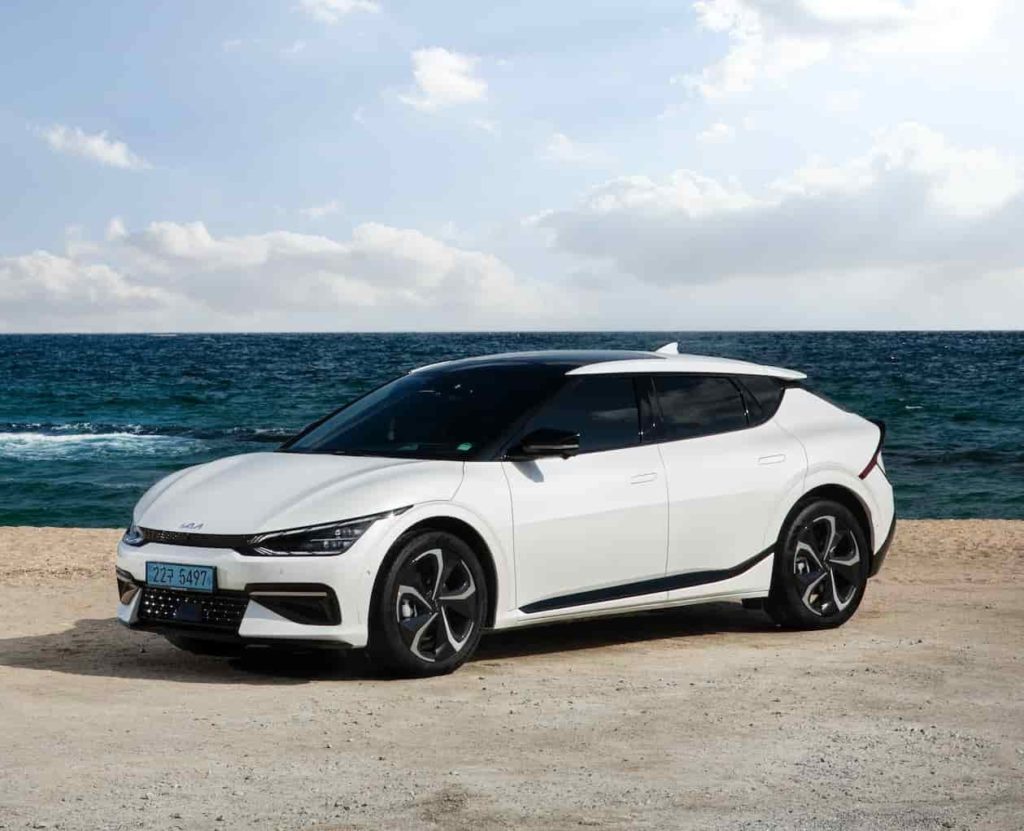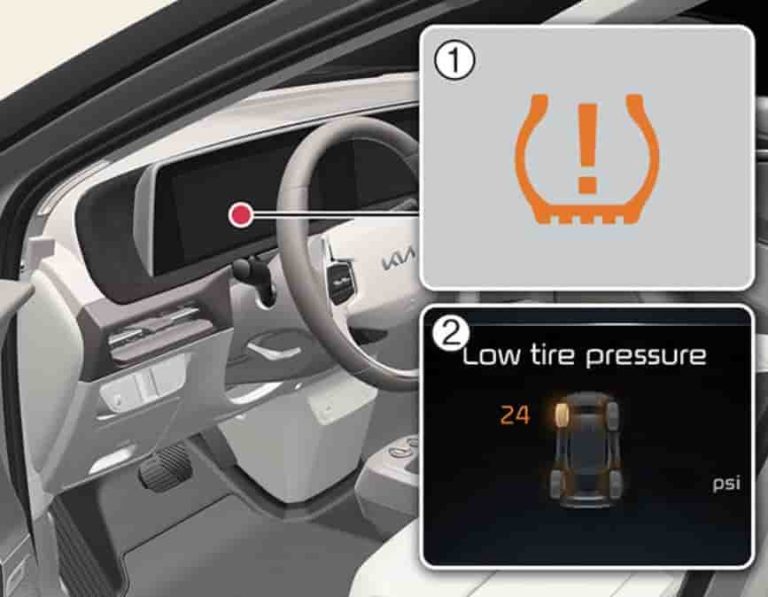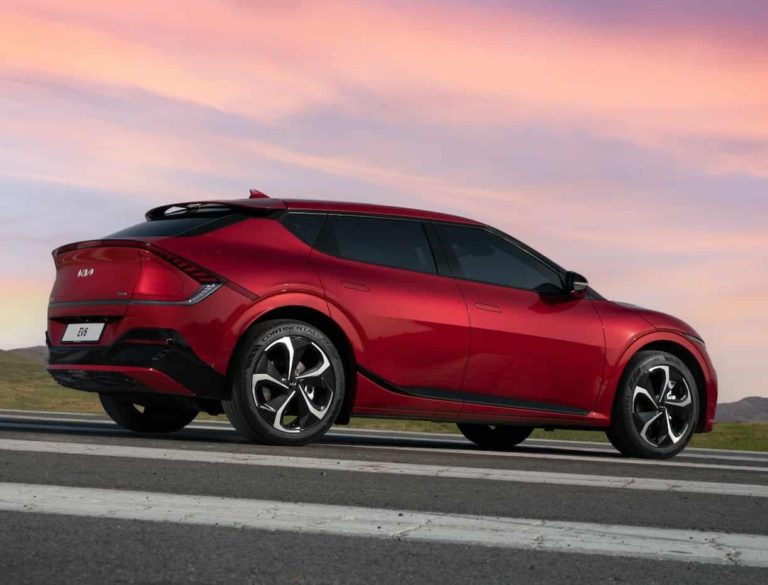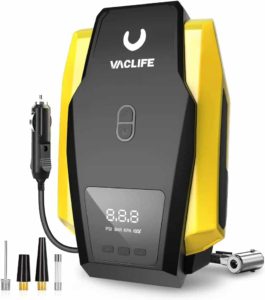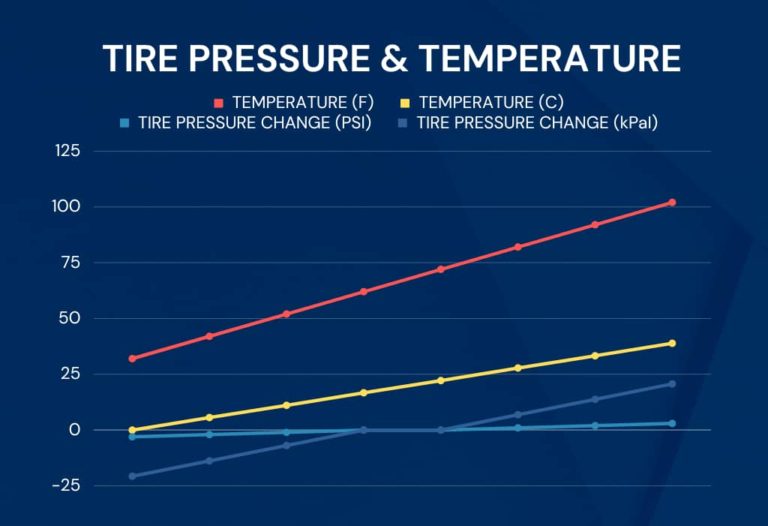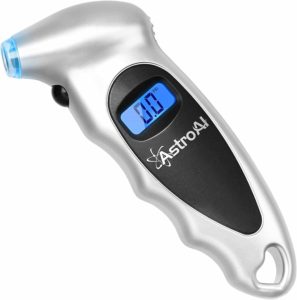The Kia EV6 doesn’t have a button to reset the tire pressure. So, if you see any videos or websites saying otherwise, just disregard them – they’re not correct. No need to stress! Just do what this article says and you’ll be able to switch off the tire pressure warning light without any issues.
What is the TPMS in the Kia EV6?
That yellow exclamation point warning symbol flashing on your dashboard may seem bothersome, but remember, it’s there for a vital purpose! The Kia EV6 tire pressure monitoring system (TPMS) is a smart feature in your vehicle that keeps an eye on your tire pressure for you. It’s designed to alert you when the pressure in one or more of your tires is too low, helping you maintain optimal tire pressure for safe and efficient driving. This system is like your personal tire-checking assistant, always there to ensure your tires are in good condition. To check your current tire pressure: Press the cluster menu button on the steering wheel. Select “information mode” from the LCD display modes. The Kia EV6 tire pressures are supposed to be 36 Psi.
2023 Kia EV6 Tire Pressures
Tire Size | FRONT PSI | REAR PSI |
235/55R19 | 36 | 36 |
255/45R20 | 36 | 36 |
SPARE TIRE | 60 | 60 |
Steps to Reset Kia EV6 Low Tire Pressure Light
The Kia EV6 does not have a tire pressure reset button.
When the tire pressure light on the dashboard lights up, pull over and check your tire pressure right away.
Determine which tire is causing the tire pressure light to turn on and adjust the tire pressure accordingly.
Fill your tire to the exact recommended pressures. I cannot emphasize this enough, accuracy is key. 36 Psi.
Drive your Kia EV6. Drive for a few minutes at speeds over 20 Mph.
If the light doesn’t go off right away, re-check your tire pressure to make sure they are all at the exact pressure you set them to. If they are down in pressure, you probably have some sort of tire leak.
If the pressures are at the exact pressure you set them to and the tire light still won’t go off, over fill your tires.
We recommend filling your problem tire with 45 Psi or about 10 Psi over the recommended pressure. With the tire overfilled, drive the car again for 10 or 15 minutes. This will turn off the tire light.
Now that the tire light is off, readjust the pressure back to 36 Psi.
How Does the Kia EV6 TPMS Work?
Pressure Sensor Placement: The TPMS in the Kia EV6 uses tire pressure sensors inside each tire, except for the spare. These sensors are attached at the end of each tire valve on the inside of the tire. (the sensors are not visible until you remove the tire from the wheel/rim)
Sensor Functionality: Each sensor measures the air pressure inside the tire. They are battery-powered and last about 5-10 years, but they will eventually need to be replaced when the battery dies. The batteries cannot be replaced.
Pressure Reading: The sensors continuously monitor the tire pressure while the vehicle is powered on. The system also monitors tire temperature.
Transmission of Data: Each sensor transmits the tire pressure data wirelessly via radio frequency to the TPMS control module (also known as the receiver), located inside the vehicle.
Pressure Standards: The TPMS control module compares the received current pressure readings with the pre-set optimal tire pressure levels, 36 Psi.
Warning Activation: If the tire pressure in any of the tires falls below or exceeds 36 Psi, the control module sends a signal to the vehicle’s onboard computer system. The system usually uses 10 or 15% as its threshold. For example, 15% of 36 Psi is 5.4 Psi. This means when the tires are at 31 Psi (36 – 5), the Kia EV6 will activate the warning light on your LCD.
Driver Notification: Upon receiving the signal from the control module the driver will be alerted that the tire pressure is not optimal. The EV6 will also specify which tires are low on pressure on the LCD.
Resetting the System: After fixing your tire pressure levels, follow the 8 steps above to reset the system.
TPMS Malfunction Indicator
Your Kia Ev6 also comes with a special indicator to let you know when the tire pressure monitoring system (TPMS) isn’t working correctly. This malfunction indicator shares a light with the low tire pressure warning. If something’s wrong with the system, the light will blink for about a minute and then stay lit. It will do this every time you start your car as long as the problem persists. If the malfunction indicator stays on after blinking for about a minute, it means the system might not be able to tell if your tires are low on air like it’s supposed to. In other words, when your tire pressure light is blinking and then stays on everytime you turn the EV6 on, the tire pressure system itself is not working correctly. This is not an air pressure problem. This usually happens when a pressure sensor battery is dead or dying. You can use a TPMS diagnostic tool to figure out which sensor is the problem.
What Sets off the Tire Pressure Light?
Seasonal temperature changes: A drop in ambient temperature can cause tire pressure to decrease, triggering the warning light.
Tire puncture or leak: A sharp object or road debris like a nail or screw may puncture a tire, causing air loss which will of course activate the warning light.
Faulty tire pressure sensor: Damaged or malfunctioning sensors may provide inaccurate readings, resulting in a false alert. The only way to determine which sensor is faulty is to scan each sensor with a TPMS diagnostic tool.
Valve stem issues: A damaged or leaking valve stem can lead to gradual pressure loss and eventual activation of the tire pressure light. They make kits to replace the rubber gasket that usually goes bad.
Tire damage: Impact from potholes or hitting a curb can cause structural damage like tire bubbles, leading to pressure loss.
Sensor battery life: TPMS sensors are battery-powered, and over time, batteries die. (they usually last anywhere from 5-10 years) This will cause the tire pressure light to turn on. Again, you must use a diagnostic tool to determine which sensor is dead or dying.
Recent tire rotation or replacement: If the tires have been recently rotated or replaced, the TPMS may need recalibration to avoid false alerts. Sometimes the vehicle’s computer may think the front tires are in the rear and rear in the front after a rotation.
Wheel or rim issues: Damaged, corroded, or cracked wheels or rims can lead to air leaks and pressure loss. This is very common with low profile tires.
Altitude changes: Climbing or descending in elevation can affect tire pressure and trigger the TPMS warning. An additional 1.5 Psi per Km above sea level is required.
Natural pressure loss: Tires lose air pressure over time due to temperature changes and permeation. Tire dry-rot will happen to tires that sit.
Electrical problems or software issues within the car’s TPMS system. Occasionally the system may have a software update.
What Happens to Underinflated Tires?
When the tires of your Kia EV6 are underinflated, it can have several impacts on your vehicle’s performance and safety.
Handling and Control: Underinflated tires can reduce the car’s handling ability, making it more difficult to steer and maneuver. The tires may not respond as quickly or accurately as they would if properly inflated, which could increase the risk of accidents, especially in challenging driving conditions.
Fuel Efficiency: Underinflated tires create more resistance or ‘drag’ on the road. In an EV, this can result in reduced range, as the car uses more energy to move.
Tire Life: Tires that are not adequately inflated will wear out faster. They will wear unevenly, with more wear on the outer edges and less in the middle, which will significantly reduce their lifespan.
Safety: Underinflated tires are more prone to overheating because they create more friction with the road. This excess heat can lead to tire blowouts.
What Happens to Overinflated Tires?
If your tires are overinflated, they have too much air. This can lead to:
Reduced Traction: Overinflation causes the tires to become too rigid, reducing the amount of tire surface that’s in contact with the road, which will decrease traction.
Increased Wear in the Center: Overinflated tires wear more in the center of the tread because they bulge outwards, causing uneven tread wear.
Increased Risk of Tire Damage: Overinflated tires are more susceptible to damage, such as punctures or tire blowouts, because they’re less able to absorb impacts from potholes or debris on the road.
How Does the Weather Affect Tire Pressure?
The tire pressure in your Kia EV6 is affected by the weather. In simple terms, when it’s cold outside the air inside your tires contracts and makes the tire pressure drop. On the other hand, when it’s hot the air expands and increases the tire pressure. That’s why you might see your tire pressure warning light come on during a sudden temperature change. It’s always a good idea to check your tire pressure when the seasons change or when there’s a big swing in temperature to make sure your tires are properly inflated. A rough rule of thumb is that for every 10-degree shift in temperature, your tire pressure is likely to drop by around 1 Psi.
How to Adjust Your Tire Pressure?
Get a high-quality tire gauge.
Make sure to check the tire pressure when the tires are cold. “Cold” means your vehicle has been idle for at least three hours or driven less than 1 mile in the past 3 hours.
Take off the valve cap from the tire valve stem.
Push the tire gauge firmly onto the valve to measure the pressure.
Compare the pressure reading with the recommended pressure on the tire information label. 36 Psi.
If the pressure is lower than 36 Psi, add air.
If the pressure is too high, let out some air by pressing the metal stem in the center of the tire valve. You can use any object like a screwdriver to do this. Be gentle.
Recheck the tire pressure with the gauge.
Don’t forget to put the valve caps back on to prevent leaks and keep dirt and moisture out.
When Should You Adjust Your Tire Pressure?/
The optimal time to adjust your Kia EV6’s tire pressure is in the morning or when your vehicle has been parked for a few hours. This is because your tires should be cold when you’re checking and adjusting the pressure. When you drive, the tires heat up, which can cause the air inside to expand and give a higher pressure reading. Do not adjust your tire pressure when your tires are hot, it will not be accurate and can lead to more issues! To get the most accurate tire pressure measurement, make sure your car has been parked for a few hours.
Conclusion
In conclusion, maintaining the right tire pressure in your Kia EV6 is essential for your safety, the longevity of your tires, and the efficiency of your EV. The TPMS in the EV6 is a valuable tool that helps you do just that. Remember, if your tire pressure warning light comes on, don’t ignore it! Use the steps provided in this guide to troubleshoot and resolve the issue. Regularly checking your tire pressure, especially when the weather changes, can help you keep your tires in great shape and get the most out of your electric vehicle. Stay safe and happy driving! Everything in this article is applicable to all Kia EV6 models and trims.
